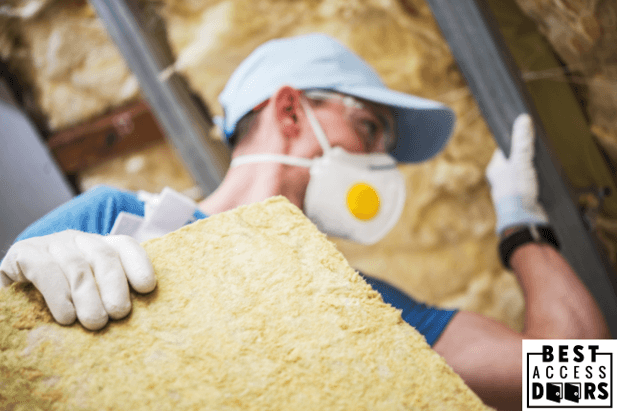Insulation Question: Clients and Contractors Have To Decide
Posted by Best Access Doors on 1st Feb 2018
To spray or not – when it comes to insulation this is a question that clients and contractors have to choose between. For many who choose to insulate on their own, the thought of spray foam insulation can be very daunting and intimidating, then again it is not an easy task. With the right equipment and understanding of the execution, spray foam insulation can be an easier and somewhat cost-effective solution, especially since the majority of most building projects will have insulation of some sort.
In residential builds, insulation is found heavily between walls and ceilings – typically a fiberglass batt insulation; however, in areas where applying a batt is difficult and limited to access, not only is spray foam helpful in hard to reach and access areas, it is a quick solution when closing the gap between access doors, windows, or frames. Spray foam is the ultimate solution to preventing conductive heat loss in a cost effective and versatile way. Spray foam is a nice alternative to fiberglass and cellulose insulation.
Insulation 101
Insulation of spray foam can be, as mentioned, somewhat complicated and for the inexperienced builder. For spray foam, there are two types to consider:
Open Cell – this particular type of spray foam has a lower R-Value therefore making it slightly cheaper than closed cell. To achieve the similar effect as a closed cell, adding an extra layer of insulation may be required.
Closed Cell - a higher grade of insulation that is a great source of moisture prevention. When used, closed cell spray foam can also help add structural support along with insulation. When it comes to installing insulation, it is important to remember than when choosing this form of insulation, it is also used as a means of closing any gaps.
Where and how to install insulation is just as important as deciding between batting or spray.
For any professional or budding insulation installer – the common practice of installing can be summed in 6-steps:
Experience no matter if you are installing the spray foam or the batting yourself, it’s important to ensure you have the necessary experience. If you are going with an installer, make sure that they are able to do it with quality, to avoid sloppy work. You will be thankful down the road – especially if there turns out to be any issues!
Having the right products sometimes cutting corners to save a buck just isn’t worth it; therefore, consulting with a specialist or a contractor will help determine what materials you need and if there are cost-saving tips to help. From the application of the insulation, to the grade, these are factors that are important to consider when picking the right product.
Preparation of both the site to be insulated but also of the materials. If you are doing the insulation yourself, ensure you have enough insulation for the square feet; however, if you are having a professional come in – preparing the area to insulate will make the process go much faster and smoother. When you hire a professional to insulate, whether they are using spray foam or batting – don’t be afraid to ask questions about how you can prepare and make the process smoother and easier.
Know your ratio – when it comes to spray foam there is a ratio that must be considered to get the material to be what is sprayed; therefore, it is important to know the proper ratio to ensure that the product will work to its fullest capacity. In a way, having a professional install spray foam insulation can be beneficial as they will have the training and experience when it comes to preparing the materials.
Store and secure the insulation at the proper temperature. No matter what brand, or type of material, manufacturers of insulation will state the ideal temperature for storage but also installation. Material that isn’t stored in the ideal temperatures can find that they don’t work to their fullest capacities. The storing of materials in ideal temperatures is one thing to consider – the other is the temperature for installation, as that can also affect effect the material!
Quality and testing is important once the waiting period has passed, especially with spray foam. Check where the insulation was installed to ensure all gaps were covered, and that there are no leaks or issues with the installation. Following up is important whether it’s a DIY or professionally done.
Adding to the list of what you must consider in an insulation process, timing and budgeting can play heavily on how you plan your project.
If you are confident in your ability to insulate with spray foam and can create the mixture without difficulties, then it can be a cost-effective approach to insulation. However, if you are more comfortable with layering, understanding the R-value, and what the numbers mean can ensure you have chosen the right insulation for the right purpose and goal.
To spray or not?
Spray foam insulation surpasses traditional rolled fiberglass insulation in terms of sophistication and performance. While it requires careful application and may be messier and more expensive than batting insulation, opting for spray foam ensures long-lasting and high-quality insulation.
To make an informed choice between the two, it is essential to assess your specific requirements. Regardless of your decision, investing in insulation initially is a wise decision.
For additional valuable tips, please visit our blog!
If you would like to explore our inventory of access panels or speak with a customer representative regarding your building needs, please give us a call.
And don't forget to check out our BA-DWT Super Insulated Crawl Space Access Door!
Share our story - the 2025 version is available

